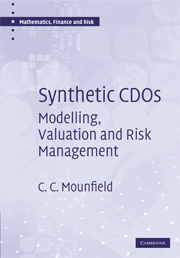Book contents
- Frontmatter
- Contents
- Preface
- Acknowledgements
- 1 A primer on collateralised debt obligations
- 2 Modelling of obligor default
- 3 Valuation of credit default swaps
- 4 Credit indices
- 5 Valuation of default baskets
- 6 Valuation of synthetic CDOs
- 7 Phenomenology of the standard market model
- 8 Risk quantification of synthetic CDOs
- 9 Implied and base correlations
- 10 Extensions of the standard market model
- 11 Exotic CDOs
- 12 Correlation trading of synthetic CDO tranches
- 13 Risk management of a portfolio of synthetic CDOs
- 14 Hedging simulation of structured credit products
- Appendix A Explanation of common notation
- Appendix B Simulated annealing
- References
- Index
5 - Valuation of default baskets
Published online by Cambridge University Press: 06 July 2010
- Frontmatter
- Contents
- Preface
- Acknowledgements
- 1 A primer on collateralised debt obligations
- 2 Modelling of obligor default
- 3 Valuation of credit default swaps
- 4 Credit indices
- 5 Valuation of default baskets
- 6 Valuation of synthetic CDOs
- 7 Phenomenology of the standard market model
- 8 Risk quantification of synthetic CDOs
- 9 Implied and base correlations
- 10 Extensions of the standard market model
- 11 Exotic CDOs
- 12 Correlation trading of synthetic CDO tranches
- 13 Risk management of a portfolio of synthetic CDOs
- 14 Hedging simulation of structured credit products
- Appendix A Explanation of common notation
- Appendix B Simulated annealing
- References
- Index
Summary
Introduction
In this chapter we introduce and analyse default baskets. As we will see in subsequent chapters there are many similarities between the modelling of default baskets and synthetic CDOs, and a lot of the technology applied to default baskets carries over to CDOs. It is these modelling similarities that motivate starting with default baskets; much of what we learn about them will prove to be useful when looking at synthetic CDOs.
The chapter begins in Section 5.2 with a brief description of what default baskets are, their economic rationale (for both buyers and sellers of protection) and the mechanics of default basket trades. Section 5.3 describes the general approach to valuing default baskets. We have already met in Chapter 2 the concepts of modelling individual obligor default as a Poisson process and saw how default correlation could be captured by the use of copula functions. In the limits of no correlation between default events or perfect correlation between default events, a default basket can be valued analytically within the standard hazard rate model. Section 5.4 describes the details of these calculations. Although these analytic limits correspond to unrealistic limiting cases, they can provide useful insight into the overall behaviour of default baskets and are therefore worthy of study.
- Type
- Chapter
- Information
- Synthetic CDOsModelling, Valuation and Risk Management, pp. 81 - 109Publisher: Cambridge University PressPrint publication year: 2008



